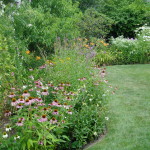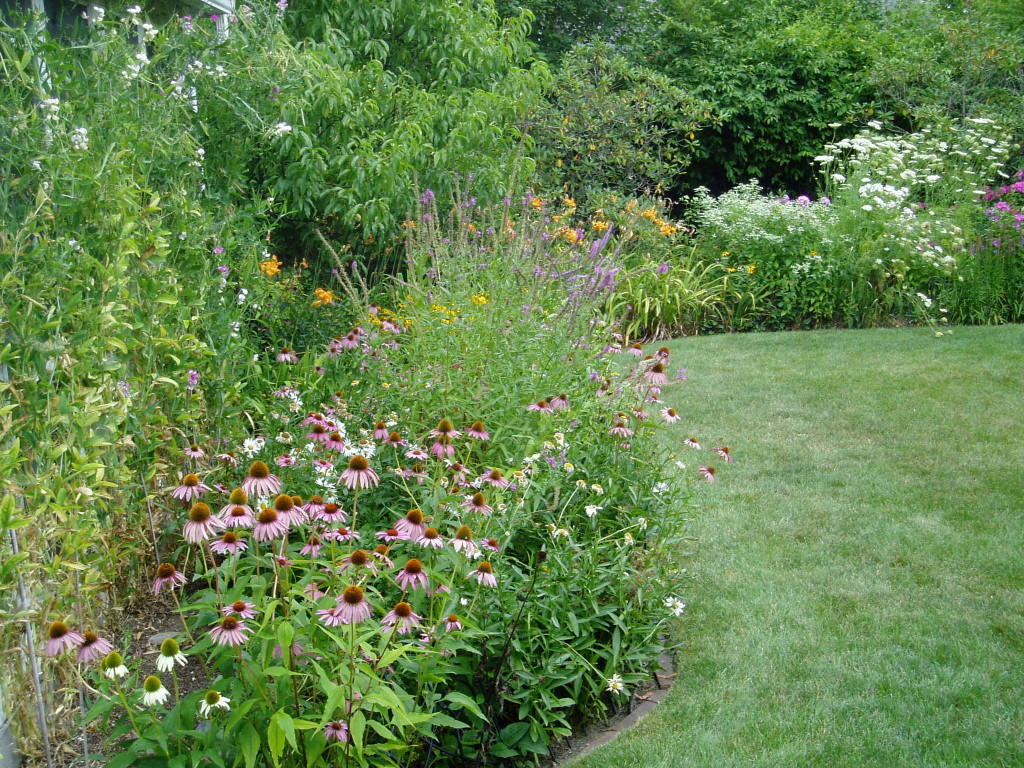
By Irene Fairley
When I moved to Winn Street in the early 1970s, the property was mostly covered in lawn, especially the back yard. This neighborhood has a high water table as the Winn Brook goes underground here and weaves over to Little Pond. I think everyone on the street has at least one sump pump. It was not unusual to have water in basements with heavy rainfall or to see water standing above ground.
My goal was to replace a large portion of the lawn with plantings that would absorb more of the rainwater and enhance habitat for birds and butterflies. All of the existing trees and shrubs were deciduous. I planted evergreens and perennials, and over several years I tried a variety of flowers. While they were attractive, the perennial beds did need watering, even in the Winn Brook’s high water table. Summers are getting hotter, and as I age, I find myself less willing to deal with hoses and watering. I decided to try a “tough love” approach to gardening: let’s see which plants survive!
Of course, it’s the drought-resistant plants that live. I gradually cut back, and I have not watered perennial beds and shrubs for the past two hot summers. I did give the white dogwood in my front yard a drink during a particularly long drought this past summer because it has to survive afternoon sun. I do not water the grass. Although it may turn brown during dry months, it comes back eventually if you don’t cut it too low. When you let grass grow tall, it grows deeper roots as well, which lets it absorb and retain more moisture during dry periods. If you have gardeners cutting the grass (as I do), you have to negotiate.
Many plants were lost over the years, including heather, thistle, scabiosa, monkshood, and clematis. More importantly, many survived.
The survivors include crocus, columbine, daylily, iris, violet, daisy, phlox, liatris, rudbeckia, mountain mint, geranium, Cerastium tomentosum (snow-in-summer), hosta, potentilla, lily of the valley, Physostegia virginiana (obedient plant), peony, perennial sweet pea, milkweed, Queen Anne’s lace, sage, thyme, chives. The raspberries, blueberries, gooseberries, a Macoun apple tree, and a white peach tree have managed as well. Many shrubs have also thrived, including butterfly bush, mountain laurel, rhododendron, spirea, vibrunum, forsythia, potentilla, red osier dogwood, holly, and royal privet. I should add that peat moss and mulch are essential for water retention.
Of course, every spring I wonder what will reappear and what battles will be waged among the plants over the summer.
The most successful plant by far has been echinacea (coneflower) which is now in five flower beds in three varieties. Purple, white, and yellow coneflowers add color to the garden, make
beautiful long-lived cut flowers, and provide food for butterflies and birds. Goldfinches will come to feed on coneflower seed heads in early spring if you leave them standing through the winter. The birds will also visit all summer once seeds form and well into fall as they prepare to migrate. They will sit on the seed cones, swinging back and forth, and are quite entertaining. Other small birds and animals eat the seeds that fall. And some of those seeds will become new plants.
Echinacea are on the list of “low water-use plants” provided by the Massachusetts Water Resources Authority on their web page “Garden and Landscaping Water Conservation Tips,” available at www.mwra.com/comsupport/conservation/gardeningtips.htm. It’s a valuable source of information for planting and maintaining lawns and gardens. I recommend it to all.
Irene Fairley retired from Northeastern University where she was a professor of English and linguistics. She now devotes more time to her art and her children and grandchildren; and, of course, to gardening.



Sorry, the comment form is closed at this time.